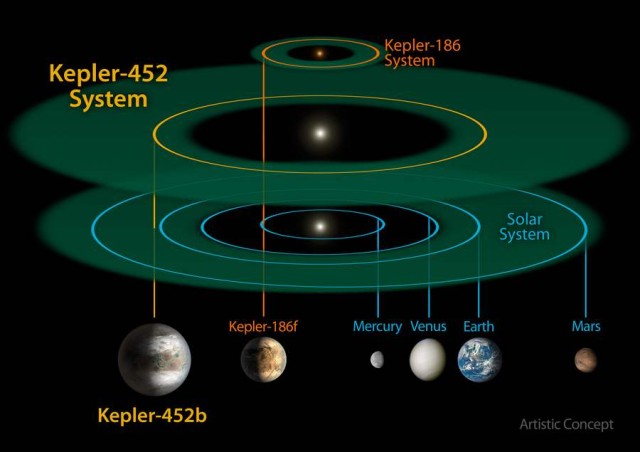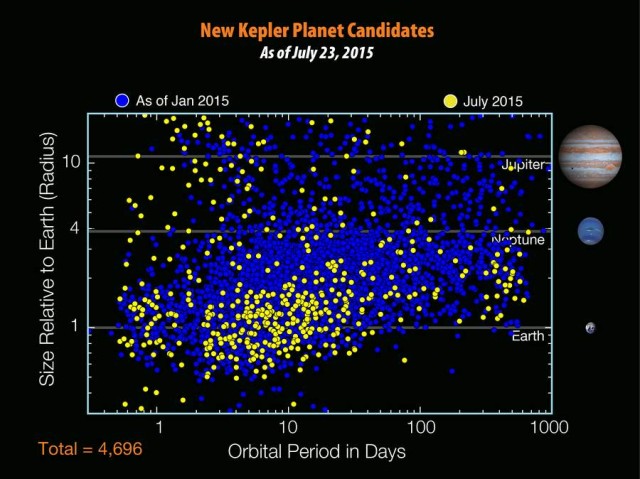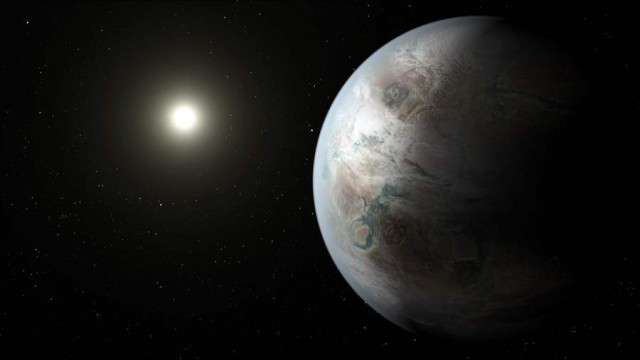NASA’s Kepler mission discovers Kepler-452b exoplanet orbiting in the habitable zone, that is the most similar yet to Earth.
Above: The possible appearance of the planet Kepler-452b, the first near-Earth-size world to be found in the habitable zone of star that is similar to our sun. Credits: NASA/JPL-Caltech/T. Pyle
Top image: This artist’s concept compares Earth (left) to the new planet, called Kepler-452b, which is about 60 percent larger in diameter. Credits: NASA/JPL-Caltech/T. Pyle
The newly discovered Kepler-452b is the smallest planet to date discovered, orbiting in the habitable zone around a sun-like G2-type star, the area where liquid water could pool on the surface of an orbiting planet.
The confirmation of Kepler-452b brings the total number of confirmed planets to 1,030.

This size and scale of the Kepler-452 system compared alongside the Kepler-186 system and the solar system. Kepler-186 is a miniature solar system that would fit entirely inside the orbit of Mercury. Credits: NASA/JPL-CalTech/R. Hurt
John Grunsfeld, associate administrator of NASA’s Science Mission Directorate at the agency’s headquarters in Washington. said:
“On the 20th anniversary year of the discovery that proved other suns host planets, the Kepler exoplanet explorer has discovered a planet and star which most closely resemble the Earth and our Sun. This exciting result brings us one step closer to finding an Earth 2.0.”
Kepler-452b is 60 percent larger in diameter than Earth and is considered a super-Earth-size planet. While its mass and composition are not yet determined, previous research suggests that planets the size of Kepler-452b have a good chance of being rocky.
While Kepler-452b is larger than Earth, its 385-day orbit is only 5 percent longer. The planet is 5 percent farther from its parent star Kepler-452 than Earth is from the Sun. Kepler-452 is 6 billion years old, 1.5 billion years older than our sun, has the same temperature, and is 20 percent brighter and has a diameter 10 percent larger.
Jon Jenkins, Kepler data analysis lead at NASA’s Ames Research Center in Moffett Field, California, who led the team that discovered Kepler-452b, said:
“We can think of Kepler-452b as an older, bigger cousin to Earth, providing an opportunity to understand and reflect upon Earth’s evolving environment. It’s awe-inspiring to consider that this planet has spent 6 billion years in the habitable zone of its star; longer than Earth. That’s substantial opportunity for life to arise, should all the necessary ingredients and conditions for life exist on this planet.”

There are 4,696 planet candidates now known with the release of the seventh Kepler planet candidate catalog – an increase of 521 since the release of the previous catalog in January 2015. Credits: NASA/W. Stenzel
source NASA






Leave A Comment